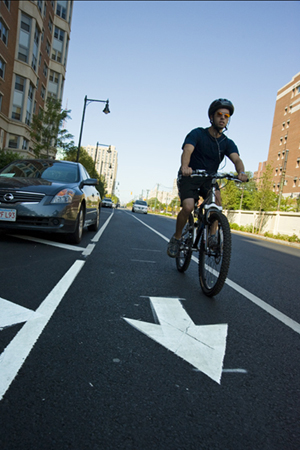Mayor: Boston to Be World-Class Biking City
BU bike lane is city’s first

After two years of construction, Commonwealth Avenue is not only safer and more attractive for pedestrians, with wider sidewalks and crosswalks and more greenery, it’s also more bicycle-friendly.
In addition to eliminating a lane of traffic on the street’s westbound side, crews have built the city’s inaugural bike lane: a one-mile stretch of asphalt from Kenmore Square to the BU Bridge.
Mayor Thomas M. Menino (Hon.’01) unveiled the new lane at an August press conference outside the College of Communication. “I’m proud to present you with Boston’s first bike lane,” he told a crowd of approximately 30 cyclists, who clapped and jingled bicycle bells. “This is the city’s first step in making Boston a world-class biking city.”
Less than a year ago, Menino launched Boston Bikes, which will create a network of bike lanes throughout Boston and add 250 bike racks across the city. (The Comm Ave construction project included the installation of bike racks.) He has appointed former Olympic cyclist Nicole Freedman the city’s bike coordinator, a position that had been eliminated in 2003.
Officials chose to build the first lane along Comm Ave because it has the highest volume of bike traffic in the city, Freedman said. A 2.2-mile lane along the American Legion Highway in Roslindale is also near completion, and lanes in the Fenway and the South End are being designed. The width of the lanes varies: four feet along curbs and five feet where there is parallel parking.
“Riding a bike in Boston is special because it brings you closer to the city,” said Menino, who gets up most days at 5 a.m. to go for a ride. “But this relationship extends beyond our neighborhoods and parks, because it also creates a fellowship with other cyclists.”
With gas prices at nearly $4 a gallon, he added, cycling is an inexpensive — and green — way to navigate the city. “Biking relieves car congestion and cuts down on carbon emissions,” Menino said. “It also promotes a vibrant economy and a superb way of life.”
To further encourage cycling, the city is promoting the fourth annual Hub on Wheels, a mass bike ride and festival that is expected to draw 4,000 riders on Sunday, September 21. Freedman is also looking into the feasibility of a bike-share program similar to Washington, D.C.’s SmartBike DC. The program would allow riders to pick up a bike at one location and drop it off at another. If all goes well, Freedman says, the city could introduce the program in spring 2010.
The city’s efforts are winning praise, and not just from local cyclists. For the past three years, Bicycling magazine has ranked Boston among the worst cities for cycling. But this year, as a result of Menino’s initiative, the magazine upgraded Boston to its “Five for the Future” list. “Watching a city like Boston turn its city cycling plans into reality has been an incredibly gratifying process for us,” writes editor in chief Steve Madden. “It’s evidence that a much-needed, far-reaching pro-cycling movement is in the works.”
Still, Boston has a long way to go before it joins the ranks of cycling meccas such as Portland, Ore., and Seattle, Wash., which are consistently ranked among the nation’s best for biking. Officer Peter Shin of the Boston University Police Department notes that because more cyclists have taken to the streets since the installation of the bike lane, the risk of accidents has increased. “It’s great that the lanes are being used,” he says, “but additional traffic creates potential safety hazards, particularly if motorists and cyclists aren’t paying attention to one another.”
Cyclists need to remember that by law they are required to follow the same road rules as motorists, Shin adds. “This means stopping at all red lights, using proper hand signals, and not making illegal left turns or biking the wrong way down one-way streets,” he says. “Wear a helmet, and don’t talk on your cell phone or text or listen to your iPod while you’re riding.”
Nonetheless, experienced bikers assure novices that it is possible to safely share the road with cars and pedestrians. Jon Allen, author of Bicycling Street Smarts, an online resource for urban cyclists, has been biking in Boston since 1971. “I’ve never had a single accident,” he says, “because I stay alert and obey all of the traffic laws.” Similarly, the worst encounter that Jon Niehof (GRS’09) has had biking to BU from Watertown was with a pothole.
“The person behind the wheel isn’t interested in hitting you,” Niehof says. “So as long as you’re following the rules and the drivers can see you, you should be okay.”
For additional information about biking in Boston, visit MassBike, Bicycle Riding School, Bicycling Street Smarts, Boston Critical Mass, and Urban Adventours.
Vicky Waltz can be reached at vwaltz@bu.edu.
Comments & Discussion
Boston University moderates comments to facilitate an informed, substantive, civil conversation. Abusive, profane, self-promotional, misleading, incoherent or off-topic comments will be rejected. Moderators are staffed during regular business hours (EST) and can only accept comments written in English. Statistics or facts must include a citation or a link to the citation.